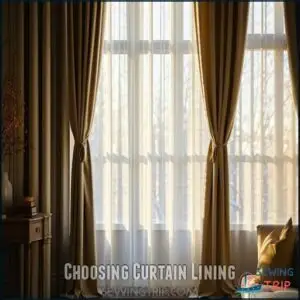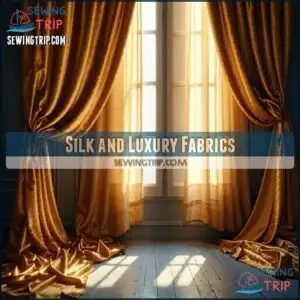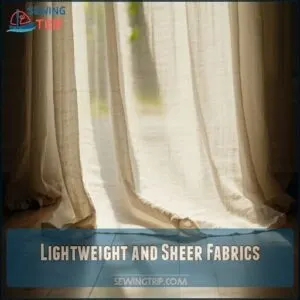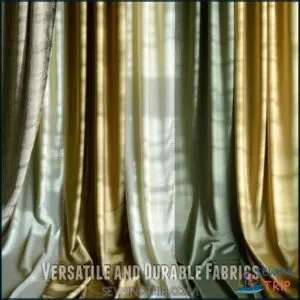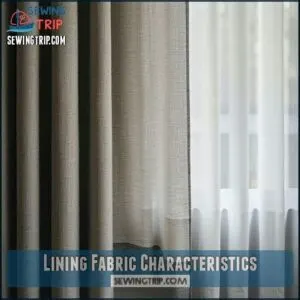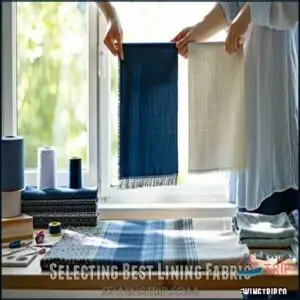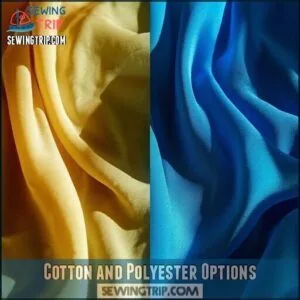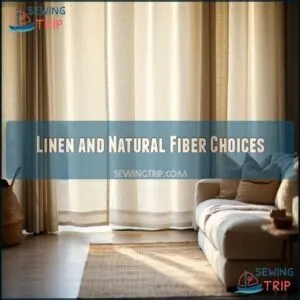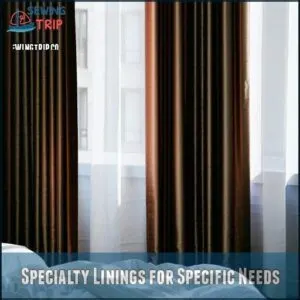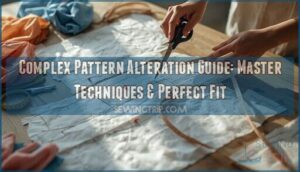This site is supported by our readers. We may earn a commission, at no cost to you, if you purchase through links.
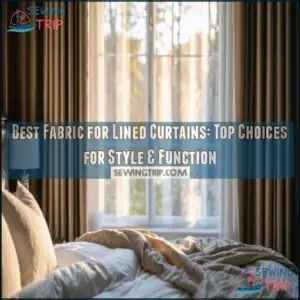
They’re practical, offering good insulation and privacy, while being strong enough to support heavier linings like blackout or thermal layers.
For a touch of luxury, silk works beautifully, though it needs a liner to protect against fading.
Linen gives you that relaxed, natural vibe but may wrinkle.
Think about your space—bedrooms often need blackout lining, while living areas might benefit from lighter fabrics with thermal properties.
The right combo balances style, function, and your lifestyle!
Table Of Contents
Key Takeaways
- Pick cotton-poly blends for durability, easy maintenance, and support for blackout or thermal linings.
- Use silk for luxurious style but add a liner to protect against fading from sunlight.
- Choose blackout linings for bedrooms or thermal layers for living areas to improve insulation and privacy.
- Match fabric weight and texture with the lining to ensure smooth draping and long-lasting function.
Choosing Curtain Lining
When choosing curtain lining, you’ll want to balance practicality with style to suit your room’s needs.
From blocking light to improving insulation, the right lining can make your curtains look better and last longer, which is a complete concept that encompasses various benefits.
Benefits of Curtain Lining
Curtain lining fabric is more than just a backdrop—it’s a game-changer for your windows.
A well-chosen curtain lining transforms your windows, delivering style, energy efficiency, and lasting durability all in one.
It enhances durability, saves energy, boosts privacy, and gives curtains a polished, pro look.
Here’s why you’ll love it:
- Durability Enhancement: Protects against sunlight and wear.
- Energy Savings: Keeps warmth in, blocks heat out.
- Privacy Increase: Keeps prying eyes away.
Types of Curtain Lining
When exploring the best lining for curtains, each type offers unique perks:
| Lining Type | Key Benefit | Best For |
|---|---|---|
| Standard Lining | Basic privacy, sun protection | Lightweight curtains |
| Blackout Options | Blocks sunlight fully | Bedrooms, media rooms |
| Specialty Materials | Moisture, noise, or thermal properties | Kitchens, cold climates |
Different materials impact the overall drape and feel.
Choose thoughtfully for style and function!
Factors to Consider When Choosing Lining
When picking the best lining for curtains, think about shrinkage concerns, sewing techniques, and project complexity.
Maintenance needs matter too—some drapery lining materials require more care than others.
For rooms needing light control, blackout lining fabric works wonders, while thermal curtain lining boosts insulation.
Considering the fabric’s weight considerations is also important for guaranteeing the lining complements the outer curtain fabric.
If DIY feels tricky, professional assistance guarantees your curtain lining fabric matches your vision perfectly.
Fabric Types for Curtains
When choosing curtain fabrics, it’s all about balancing style and practicality to match your space.
From luxurious silk to durable cotton and breezy sheers, each option offers unique benefits for both appearance and function.
Silk and Luxury Fabrics
Silk curtain fabric adds elegance with its smooth texture and shimmering appearance.
Its durability depends on weave variations and proper care, as it’s sensitive to sunlight.
Dyeing silk offers vibrant, rich colors, while silk blends provide luxury with better resilience.
Remember, lined curtain fabric like this requires careful handling—think dry cleaning only.
For unmatched grace, velvet curtain fabric complements silk beautifully, creating an atmosphere of elegance with luxury.
Lightweight and Sheer Fabrics
Sheer curtains offer light filtering effects while enhancing privacy with their airy elegance.
Materials like linen fabric or lightweight cotton fabric combine sheer durability with effortless drape styles.
Layering sheer fabrics adds depth and sophistication, perfect for transforming living spaces.
These materials typically weigh between 30-150 GSM, offering breathability.
Whether for subtle light filtration or breezy aesthetics, pairing sheer fabrics with proper drapery lining guarantees both style and function.
Versatile and Durable Fabrics
Need curtains that stand the test of time? Durable curtain fabrics are your answer.
Blended fabrics offer strong weave strength and resist wear. Look for curtain lining fabrics with colorfastness testing to keep colors bright.
Plus, stain resistance simplifies upkeep. Choose materials with solid fabric properties to enhance fabric lifespan and pair with drapery lining materials for extra durability.
Lining Fabric Characteristics
When you choose lining fabric for curtains, it’s important to focus on key features like insulation, texture, and durability.
These characteristics both impact how your curtains look and feel and also how well they perform in enhancing your space with durability.
Blackout and Thermal Properties
When choosing drapery lining material, blackout lining and thermal lining stand out for their practical benefits.
These fabrics enhance energy savings by improving insulation factors, keeping rooms cozy in winter and cool in summer.
With high fabric density, light blocking curtains offer superior temperature control.
They’re perfect for energy efficient curtains, bedrooms, and nurseries, ensuring comfort and privacy.
Texture and Aesthetic Value
In terms of texture and aesthetic value, curtain linings influence how your drapes look and feel.
Here’s what to focus on:
- Fabric Sheen – Adds elegance with a reflective finish.
- Layered Textures – Combine formal or casual vibes by mixing fabric textures.
- Color Harmony – Align lining with fabric colors for balance.
- Decorative Linings – Boost visual weight and highlight fabric patterns.
Durability and Maintenance
A fabric’s durability depends on how well it resists wear, fading, and sunlight damage over time.
Regular cleaning frequency is key—follow fabric care tips to avoid shrinking or discoloration. Opt for washing methods that preserve fibers, and prioritize stain removal early.
High-quality linings with strong wear resistance last longer, making maintenance easier and keeping your curtains in top shape. Consider how fabric weight considerations impact longevity.
Selecting Best Lining Fabric
When selecting the best lining fabric, you’ll want to evaluate the room’s function, lighting needs, and fabric type to guarantee compatibility.
A good lining enhances insulation, privacy, and durability, making your curtains both stylish and practical.
Assessing Room Purpose and Lighting
Think about your room’s purpose to narrow your options.
Bedrooms benefit from light-blocking curtains for better sleep, while living rooms often need light control and privacy.
Prioritize energy efficiency in drafty spaces, like large windows.
Combine functional needs with aesthetic goals—whether it’s total room darkening or a softly filtered glow, aligning your window treatments with usage creates the perfect ambiance.
Considering Fabric Weight and Texture
Matching fabric weight and texture with curtain linings guarantees lined curtains hang beautifully.
Fabric harmony comes from balancing weight distribution and texture contrast.
Consider the following pairing guidelines:
- Heavier fabrics like velvet need sturdy lining for drape enhancement.
- Lightweight fabrics pair best with softer linings for smooth flow.
- Satin or silk benefits from linings that reduce slippage.
- Rough textures demand smoother linings for balance.
Evaluating Climate and Insulation Needs
When choosing curtain lining, climate considerations are key.
Thermal insulation helps retain heat in winter, while energy-efficient curtains block summer heat. Blackout lining adds privacy and aids window insulation year-round, delivering cost savings.
For example: Selecting the right material can guarantee optimal breathability and comfort.
| Season | Challenge | Solution | Benefit |
|---|---|---|---|
| Winter | Heat loss | Thermal insulation | Lower heating costs |
| Summer | Excess heat | Energy-efficient fabric | Cooler rooms, save energy |
| All-Year | Outdoor light | Blackout lining | Privacy, stable comfort |
| Variable Climate | Temperature swings | Versatile fabric insulation | Comfortable interiors |
Curtain Lining Materials
In regard to curtain lining materials, you’ll find a range of options intended to improve both function and style.
From durable cotton to light-filtering linen and energy-saving specialty linings, choosing the right one can transform your curtains into a practical and stylish feature of your space.
Cotton and Polyester Options
Cotton curtain fabric is loved for its durability and timeless look, giving curtains a polished vibe.
Polyester curtain fabric boasts affordability and low maintenance, ideal for busy households.
Blends combine the benefits of both, balancing strength and softness. You can find cotton lining options online.
However, care differences matter—cotton may wrinkle, while polyester resists it. Choose drapery lining types based on durability and aesthetic impact.
Linen and Natural Fiber Choices
Linen curtain fabric offers natural aesthetics and a lightweight, relaxed look, perfect for creating airy spaces.
Its durability makes it ideal for long-term use, though it might need special care. Natural fibers like linen often feature weave variations and blending options, adding charm and texture.
For versatile drapery linings, linen combines function and style effortlessly, elevating cotton curtain fabric alternatives, with its natural fibers.
Specialty Linings for Specific Needs
Specialty linings tackle specific challenges with style and precision.
Noise reduction and soundproof curtain fabric keep your space peaceful, while UV protection linings guard against sun damage.
Fire retardant options enhance safety, and antimicrobial linings reduce allergens.
For damp spaces, moisture barriers prevent mold.
To further improve sound dampening consider specialized soundproofing options.
These drapery lining choices pair beautifully with blackout fabric or energy-efficient curtains for maximum functionality, providing noise reduction and UV protection.
Frequently Asked Questions (FAQs)
What fabric is best for lining curtains?
For curtain linings, polycotton sateen twill is a top choice.
It’s durable, crease-resistant, and easy to clean.
Its soft sheen pairs well with most curtain fabrics, adding insulation and luxurious draping without complicating maintenance.
What is the best fabric for insulating curtains?
In the context of insulation, think of thermal lining as a cozy blanket for your windows.
Pair it with dense fabrics like velvet or heavy cotton to trap heat, lower energy bills, and stay snug.
What fabric makes the best curtains?
You’ll want to pick a fabric that balances durability and style.
Cotton offers versatility, silk adds elegance, and linen provides an airy vibe.
For practicality, polyester shines with easy care, while velvet screams luxurious charm.
What is the best interlining for curtains?
Imagine a cozy winter evening—choose a cotton-flannel interlining for its warmth and fullness.
It’s ideal for thermal insulation and soundproofing, creating luxurious drapes that feel elegant yet practical, perfect for turning your space into a retreat.
How to clean lined curtains without damage?
Gently vacuum both sides using a brush attachment, then spot-clean stains with mild detergent and water.
Never soak them—moisture can damage linings.
For deep cleaning, trust a professional service to avoid shrinkage or distortion.
Can lined curtains reduce external noise levels?
Lined curtains are like a cozy hug for your windows, reducing noise by absorbing sound waves.
While they won’t completely block external noise, fabrics with thicker linings, like interlining, noticeably dull loud disturbances.
What tools are necessary for sewing lined curtains?
You’ll need fabric scissors, measuring tape, pins, a sewing machine, thread, and an iron.
Seam ripper helps fix mistakes. Add a cutting mat and ruler for precision.
Patience and coffee also work wonders!
Are lined curtains suitable for outdoor use?
Lined curtains generally aren’t ideal for outdoor use due to their susceptibility to moisture, UV damage, and mildew.
Opt for outdoor-specific fabrics like acrylic or polyester blends, which withstand weather conditions and maintain durability.
How to match linings with patterned fabrics?
Pair lighter patterns with neutral linings to enhance their vibrancy.
For bold designs, use blackout or thermal linings to balance heaviness.
Match fabric weight for ideal drape, ensuring the lining complements without overpowering the patterned appeal.
Conclusion
Imagine this scenario: dialing up a rotary phone when all you need is speed-dial—that’s what choosing the wrong fabric for lined curtains feels like.
The best fabric for lined curtains isn’t just about looks; it’s a balance of style, durability, and function.
Whether you opt for practical cotton-poly blends, luxurious silk, or relaxed linen, consider your room’s needs, lighting, and insulation.
Blackout linings suit bedrooms while lighter, thermal layers shine in living spaces.
Make a smart, stylish choice!

